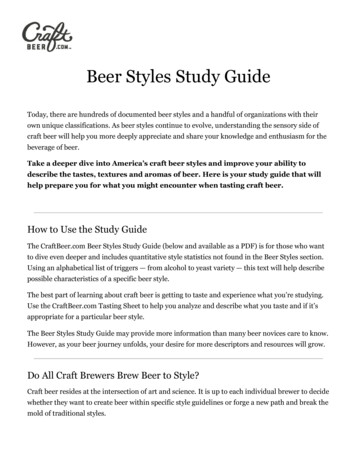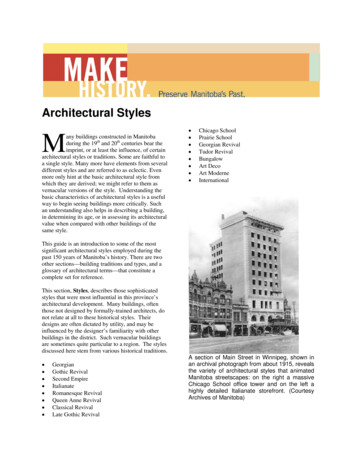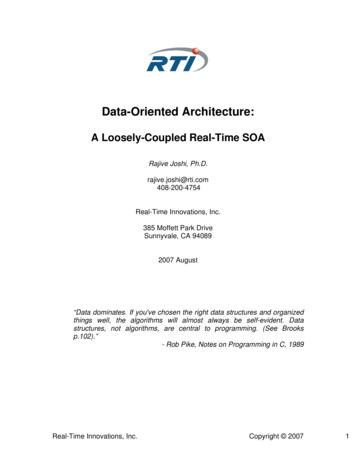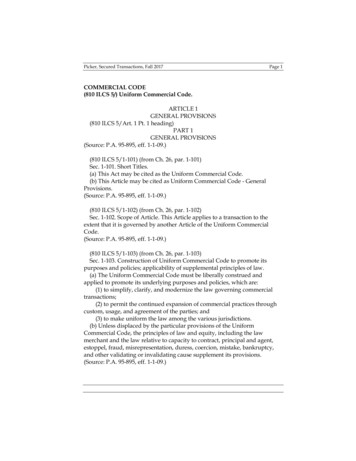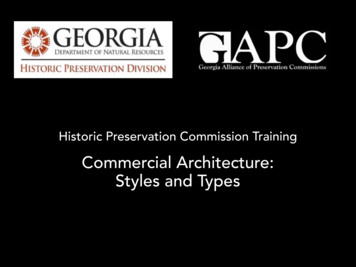
Transcription
Historic Preservation Commission TrainingCommercial Architecture:Styles and Types
StyleStyle is the particular combination ofdetails, architectural elements, windowpatterns, finishes and materials thatidentify a building as being part of alarger aesthetic idea of how a buildingappears.Not every building has a style. Folkbuildings following local traditions arecalled “vernacular”.Buildings are not always one style; theycan be a combination of two or morestyles.A building that is features a high-qualityidentifiable style throughout is called“high style”.TypeType refers to the pattern of roomlayout, form and scale that identify abuilding as belonging to a commontradition that often does not exhibit aparticular style, i.e. vernacular.Building types are determined bylooking at a building’s original form, i.e.without consideration for lateradditions or modifications.Building types can correspond toparticular periods of history, but this isfrequently not so. Some building typeswere common for fifty or more years.Others went out of use for decades butreappeared later on.
GeorgianGothic RevivalTudor RevivalGreek RevivalStyleFederalRomanesque Revival
Community StoreCorner StoreSingle RetailMultiple RetailRetail and OfficeOffice TowerGeorgia’s Commercial Types
Typically found in rural areas, neighborhoods, and edges of small townsCommon between 1890 and 1930Typically front-gabled or with front parapetTypically symmetrical front wall with a central entrance flanked by windowsOften with high windows running down the sidesCommunity Store
Typically found within towns and citiesCommon between 1900 and 1940sTypically angled corner entry oriented toward street intersectionSometimes detached, though often part of commercial streetscapesCorner Store
Typically found within towns and citiesCommon between 1880 and 1950sTypically with three-bay façadeTypically with a front parapet and a flat roof sloping toward rearMultiple RetailSingle Retail
Single most common commercial building type in GeorgiaCombination street-level retail with rental office space aboveCommon between the 1880s and 1930sFound in cities, towns, and even some crossroads communitiesTypically two to four stories tall with flat or gabled roofsRetail and Office
Most often found within larger citiesCombination street-level retail with rental office space aboveCommon between the 1910s and 1920sAlmost always architect-designed and with discernible styleTypically six or more stories tallOffice Tower
American Architectural StylesEighteenth CenturyNineteenth CenturyTwentieth CenturyEnglish PostmedievalSpanish ColonialDutch ColonialFrench ColonialGeorgianFederalEarly Classical RevivalGreek RevivalGothic Revival & Carpenter GothicItalianateEgyptian RevivalSecond EmpireStick Style/EastlakeShingle StyleQueen AnneRomanesque RevivalRichardsonian RomanesqueHigh Victorian GothicItalian Renaissance RevivalChateauesqueBeaux ArtsArts & CraftsPrairieCraftsmanColonial Revivals: Georgian/Federal Revival Dutch Colonial Revival Spanish Colonial Revival/MissionNeoclassical RevivalNeo-Gothic & Collegiate GothicMediterranean RevivalTudor/English Vernacular RevivalFrench Vernacular RevivalMinimal TraditionalArt DecoModernist/International StyleGoogies/Roadside ArchitectureThere are few 18th c buildingsremaining in Georgia. Those thatdo remain are primarilyvernacular forms with simpledetails.Georgia architecture began toregularly follow architectural fashionin the 19th c. As the state expandedinland, new buildings reflected thepopular styles of the era20th c Georgia architecture reflectsalmost all of the nationally-populararchitectural styles.
Georgia’s Commercial Architectural StylesEighteenth CenturyNineteenth CenturyTwentieth CenturyEnglish PostmedievalSpanish ColonialDutch ColonialFrench ColonialGeorgianFederalEarly Classical RevivalGreek RevivalGothic Revival & Carpenter GothicItalianateEgyptian RevivalSecond EmpireStick Style/EastlakeShingle StyleQueen AnneRomanesque RevivalRichardsonian RomanesqueHigh Victorian GothicItalian Renaissance RevivalChateauesqueBeaux ArtsArts & CraftsPrairieCraftsmanColonial Revivals: Georgian/Federal Revival Dutch Colonial Revival Spanish Colonial Revival/MissionNeoclassical RevivalNeo-Gothic & Collegiate GothicMediterranean RevivalTudor/English Vernacular RevivalFrench Vernacular RevivalMinimal TraditionalArt DecoModernist/International StyleGoogies/Roadside ArchitectureThere are few 18th c buildingsremaining in Georgia. Those thatdo remain are primarilyvernacular forms with simpledetails.Georgia architecture began toregularly follow architectural fashionin the 19th c. As the state expandedinland, new buildings reflected thepopular styles of the era20th c Georgia architecture reflectsalmost all of the nationally-populararchitectural styles.
Old Medical College of Georgia - Augusta1834207-211 Water Street - New York1835-36Greek RevivalGreene County Courthouse - Greensboro1848-49
Morgan County Courthouse - Madison1905City Hall - Athens1904Bank Building - Augustac 1850-90NeoclassicalRevival
US Post Office Annex (MLK Federal Bldg) - Atlanta1931-32Oconee County Courthouse - Watkinsville1939US Post Office - Greensboroc 1939StreamlinedClassical
City Hall - Atlanta1930Old State Capitol - Milledgeville1835US Post Office and Court House - Atlanta1873-76GothicRevivals
Hall’s Block - Dahlonega1882-83Old Lumpkin County Jail - Dahlonega1884ItalianateOld City Hall and Fire House - Madison1887
Hay House - Macon1855-59US Post Office & Court House - Valdosta1908-10Italian Renaissance RevivalsIron Bank Building - Columbus1860-67Crum & Forster Building - Atlanta1926
Hurt Building - Atlanta1913-26Carnegie Library - Atlanta1900US Post Office and Court House - Atlanta1911Beaux-Arts
Central of Georgia Railway Office - Savannah1886Fire Station #6 - Atlanta1894Savannah Cotton Exchange1886RomanesqueRevivalsOglethorpe County Courthouse - Lexington1887
Georgia Tech Tower - Atlanta1887-88Dixie Coca-Cola Bottling Plant - Atlanta1891Queen AnnePoetter Hall - Savannah1892
US Post Office - Madison1937City Hall - Madison1939The Georgian - Athensc 1910Colonial Revival:Neo-Federal and Neo-GeorgianUS Post Office and Court House(First American Bank & Trust)- Athensc 1906
Henrietta Building - Athensc 1925CraftsmanVirginia-Highland Neighborhood - Atlantac 1925Highland Woodworking - Atlantac 1925
Avondale Estates1924Tudor Revival
Paxton’s Shoe Store - Valdostac 1930Campus Theater - Milledgeville1935Bobbie’s Diner - Savannahc 1955Majestic Diner - Atlanta1929Art Deco/Streamlined Moderne
The Drayton Arms - Savannah1951Modernist/International Style
Savannah Blue Print Co.c 1960Amoco Station - Statesboroc 1955First Franklin Financial - Greensboroc 1965Georgia Power (now Georgia Military College) - Madisonc 1959Lamar Lewis Shoes - Athensc 1955Modernist/International Style
Googies & Roadside Architecture
Neo-Traditional Infill
Vernaculars
Manufacturing/Industry
For further reference see:Georgia Historic Preservation Division:http://georgiashpo.org/technical assistanceA Field Guide to American Houses,Second EditionVirginia Savage McAlesterHistoric American Building eorgia Sanborn Fire Insurance Maps:http://dlg.galileo.usg.edu/sanborn/The Elements of Style: An Encyclopediaof Domestic Architectural DetailCalloway, Powers & Cromley, edsWhat Style is It? A Guide to American ArchitectureJohn C. Poppeliers and S. Allen Chambers, Jr.
Georgia architecture began to regularly follow architectural fashion in the 19th c. As the state expanded inland, new buildings reflected the popular styles of the era There are few 18th c buildings remaining in Georgia. Those that do remain are primarily vernacular forms with simple detai


